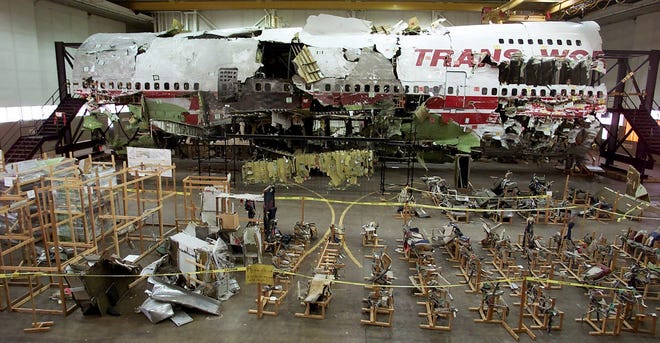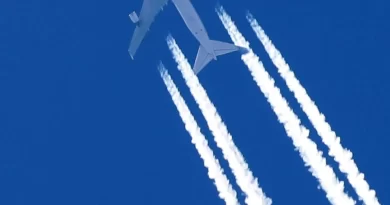‘First conspiracy of the internet age’ lives on 25 years after TWA Flight 800 exploded
On July 17, 1996, a Boeing 747 exploded in midair off the coast of Long Island. The flight from New York City to Rome with a stop in Paris broke apart and fell into the ocean below. The 230 people on board Trans World Airlines Flight 800 perished.
As quickly as the wreckage plunged into the Atlantic Ocean, questions arose. Conspiracy theories took shape.
Twenty-five years later the questions and conspiracies live on.
Following a four-year, $40 million investigation — the longest in the history of the National Transportation Safety Board — board officials concluded an electrical failure ignited fuel vapors in a nearly empty tank in the belly of the jet.
Theories that Flight 800 may have been destroyed by a bomb, missile or meteor have nonetheless lingered.

As recently as July 2014, NTSB officials had to publicly respond to requests to reconsider its findings in the investigation of the 1996 crash. Petitioners from a high-profile group called The TWA 800 Project claimed a “detonation or high-velocity explosion” caused the crash. An NTSB review determined the claim cast insufficient doubt of a flawed initial investigation.
On the day of the crash, witnesses said they saw a streak of light near the plane and one or more explosions near the aircraft. Speculation that the crash had been triggered by a proximity-triggered rocket, missile or flare bloomed.
The day after the crash, the possibility that an explosive device was fired toward the plane or placed inside before takeoff took hold. The Federal Bureau of Investigation considered potential terrorist links and began a criminal investigation.
Conspiracies were born
At the time, fears of domestic terrorism were high. The nation was still processing the 1993 World Trade Center bombing, the 1995 Oklahoma City explosion and the trial of Ramzi Yousef for conspiracy to destroy American-bound airliners. Ten days after the crash, a bombing rocked the Atlanta Olympics.
NTSB officials quickly said the initial evidence surrounding the crash of Flight 800 did not point to an outside explosive device. Still, speculation stemming from eyewitness accounts spread through chat rooms on the burgeoning World Wide Web.
Shane Miller, a professor at Saint John’s University in Minnesota who researched the conspiracy theories surrounding the crash, said the Flight 800 conspirators used the web in novel ways.

“It was really the first conspiracy of the internet age,” Miller said. “It was the first to be picked up and widely circulated online.”
Michael Barkun, professor emeritus of political science at Syracuse University’s Maxwell School, said internet forums and social media platforms have served as mass media outlets without gatekeepers. They allow unconventional ideas to quickly become mainstream.
“Now anyone with an idea, no matter how bizarre, has a way of potentially getting it in front of fairly large audiences,” he said. “That has eroded what was once a firm boundary between the fringe and the mainstream.”
Accidents that changed aviation:Controlling in-flight fires and more
Ted Goertzel, emeritus professor of sociology at Rutgers University in Camden, said the internet has been a game changer for conspiracy theory consumption and evolution. The way the theories germinate nonetheless remains relatively standard.
Conspiracy theories regularly emerge from idle speculation in the face of more probable explanations, Goertzel said. They often gain acceptance and spread from those “who score low in measures of interpersonal trust and general agreeableness,” he added.
“Someone says, ‘I wonder if X happened’,” Goertzel said. “Someone else says, ‘I heard X’ and it spreads.”
As the theory that federal officials were covering up a terrorist attack to thwart panic spread, it evolved and eventually split, Miller said. Both camps agreed on a government coverup. However, the divergent group blamed friendly fire.
One early version posted online alleged the crash resulted from an attack designed to kill Henry Kissinger, who was not on board. Another claimed the friendly fire was designed to kill former Arkansas State Troopers once assigned to then-President Bill Clinton’s security detail.

The one that took off was an August 1996 America Online post claiming the airplane was “shot down by a U.S. Navy guided-missile ship.” The information came from Richard Russell, a 66-year-old former United Airlines pilot and safety representative for the Air Line Pilots Association.
It was later progressed by Pierre Salinger. Once John F. Kennedy’s press secretary, Salinger misrepresented the post as a document he obtained by someone in French intelligence that originated from a Secret Service agent with U.S. Navy contacts before a CNN reporter pointed out the similarities.
High-profile supporters can help build a case for a conspiracy theory, even if their reputation was built in another area of expertise, Miller said. In this case, Russell said a long-time friend said he had radar footage that showed a missile traveling toward the plane just prior to the crash.
Russell’s message was meant for an inner circle of aviation experts but was leaked online. It ended up a topic of discussion at a Sept. 16 NTSB news briefing on Long Island after media outlets began to investigate.
Easy to blame the government
Governments are common targets for conspiracy theories, according to Goertzel. They offer someone tangible to blame for unfortunate events, are often disliked and rarely give immediate, comprehensive or definitive answers. Even when government officials respond with emphatic denials, distrust is common.
“A common rhetorical device of conspiracy theorists … is to advance speculations and then criticize the authorities for not definitively refuting them,” Goertzel said. “They also rely on an inherently implausible claim of a coverup by government agencies that don’t really have a very good record of covering things up.”
Russell followed up his claim with a radar tape he said amounted to proof of a rocket strike. Again, Salinger progressed the claim. Ultimately, NTSB officials determined the alleged evidence was a “ghost” signal produced by another jet airplane.
The personal investment involved in accepting or progressing conspiracy theories can make them tough to dismiss, Barkun said. Corroborating evidence is nice but not necessary. Moreover, contrary evidence can easily be dismissed as another stage in the alleged conspiracy’s coverup.
“The conspiracy theory then becomes a closed system,” Barkun said. “There’s no way to disprove it.”
TWA Flight 800 investigation
During the NTSB’s four-year investigation, federal officials obtained signed certifications from U.S. military chains of command running crash area assets, training exercises and armaments capable of reaching the aircraft. They also essentially pieced 95% of the plane back together over a 30-month span.
Purported evidence of a missile strike dried up. CIA analysts determined the Linda Kabot photo of a missile in flight was taken from the opposite direction and featured an airplane flying the opposite way. Another photo that appeared to show an object near the airplane showed debris on the film surface, FBI officials said.
The airplane’s oddly stained upholstery brought to light by TWA’s chief 747 pilot Robert Terrell Stacey also proved to have a less than salacious origin. Once subjected to microscopic and chemical examination, federal investigators found the red flaky residue was from contact adhesive used to stick the upholstery to its foam base, not rocket fuel.
NTSB officials said any internal speculation into bomb and missile theories dried up within months. Michael Marx, a former metallurgist with the NTSB said FBI personnel unreasonably pushed the sabotage theories, even after a January 1997 ATF report pegged the cause as a mechanical failure.

“By the fall of 1996, in looking at all of the physical evidence and not seeing any evidence of any bomb or missile damage, it became unreasonable to continue to push that theory,” he said during a May 1999 congressional hearing.
Still, doubt lingered. Henry Hughes, a senior accident investigator with the NTSB, was among the group that in 2013 unsuccessfully petitioned the NTSB to re-investigate the crash.
During the investigation, FBI officials demanded full control over photographs and were inconsistently inventorying, handling and analyzing aircraft components, NTSB officials said. Meanwhile, the NTSB’s assessment overlooked evidence of a missile strike, such as radar data, witness statements and holes in the fuselage, according to Hughes.
Ask the Captain:The unnecessary mystery of EgyptAir 804
The finger-pointing and varying interpretations of the data between officials at the federal agencies added to the uncertainty, Miller said. Combined with concurrent reporting about real government experiments and other real conspiracies, a tone had been set, he added.
“They really did create a perception that nobody had a clue of what had happened,” Miller said.
What really happened to Flight TWA 800?
Ultimately, NTSB officials proved that an electrical short could have sparked flammable vapor trapped in a nearly empty fuel tank and concluded that was the likely cause of Flight 800’s demise.
The finding led to regulations requiring a system that pumps inert gas into fuel tanks as they empty. They also spurred the aircraft producer, Boeing, to replace the brittle old wiring on other 747s and redesign their air conditioning packs.
Still, investigators seemed to have difficulty finding a definitive answer for the trails of light witnesses claimed to see near the plane, Miller said. As long as there is ambiguity surrounding the crash, conspiracy theories will remain, Barkun said.
Other potential causes introduced in late 1990 persist along with the friendly-fire claim more than two decades later. One alleged the plane may have been struck by fragments of a meteor that broke up as it entered the Earth’s atmosphere. Another, from Harvard professor Elaine Scarry, claimed electromagnetic interference from a nearby U.S. Navy aircraft triggered the explosion.
America’s first mass shooting:A 70 years ago, an NJ WWII veteran killed 13 of his neighbors
People have an innate desire to explain evil and misfortune, Barkun said. They also have an aversion to the idea that the world is random — even if that means there is some evil force creating the order, he added.
“Conspiracy theories never die,” Barkun said. “There’s no way really to test them.”
David Zimmer is a local reporter for NorthJersey.com. For unlimited access to the most important news from your local community, please subscribe or activate your digital account today.


